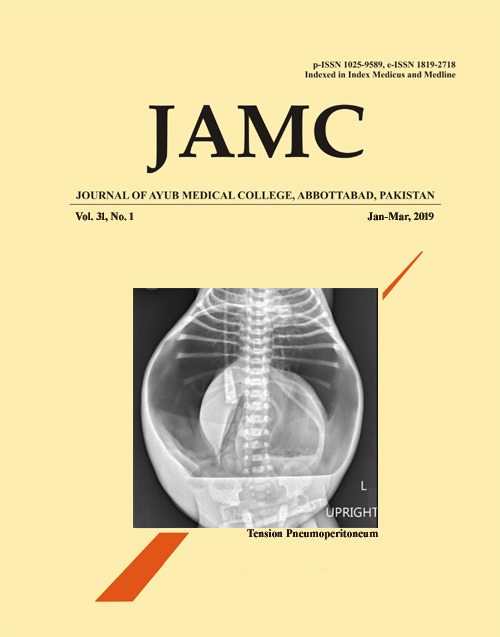VITAMIN D PROFILE OF OUTDOOR PATIENTS PRESENTING WITH ACHES AND PAINS
Abstract
Background: Vitamin D, a fat-soluble vitamin, plays regulatory role in more than 300–800 genes. Daily requirement of vitamin D depends upon the age and exposure to sun. Approximately one billion people in different parts of the world including Pakistan are either Vitamin D deficient or have insufficient levels of vitamin D. The present study, a descriptive cross-sectional study, aimed at knowing the status of vitamin D3 in outdoor patients from Hazara division, having aches and pains. It was conducted over a period of four years on 453 outdoor patients of either sex and all the age groups presenting to Ayub Teaching Hospital. Sample was selected by non-random convenience sampling technique Methods: Common causes of aches and pains other than Vitamin D deficiency were excluded by history, examination and basic laboratory tests. Vitamin D3 estimation was done by immunoassay. Results: Mean age of the participants was 40±19.62 years; the mean level of vitamin D was 21.88±14.12 ng/ml. As much as 398 (87%) participants aged 20–60 years were either vitamin D3 deficient 330 (69.9%), or had vitamin D insufficiency 68 (17.7%). Gender wise, 295 (65%) were females and 158 (35%) males, with female to male ratio of 1.29:1. Normal vitamin D3 level was detected in 55 (12.5%) participants with male predominance. Conclusion: Vitamin D deficiency is alarmingly high in patients presenting with aches and pains, in all age groups, effecting females more than males.Keywords: Vitamin D; Cholecalciferol; Ergocalciferol; Sunlight; Rickets; OsteomalaciaReferences
Holick MF. Vitamin D deficiency. N Engl J Med 2007;357(3):266–81.
Bischoff-Ferrari HA, Giovannucci E, Willett WC, Dietrich T, Dawson-Hughes B. Estimation of optimal serum concentrations of 25-hydroxyvitamin D for multiple health outcomes. Am J Clin Nutr 2006;84(1):18–28. [Erratum, Am J Clin Nutr 2006;84:1253].
Cashman KD, Dowling KG, Škrabáková Z, Gross MG, Valtueña J, Henauw SD, et al. Vitamin D deficiency in Europe: pandemic? Am J Clin Nutr 2016;103(4):1033–44.
Ritu G, Gupta A. Vitamin D Deficiency in India: Prevalence, Causalities and Interventions. Nutrients 2014;6(2):729–75.
van Schoor NM, Lips P. Worldwide vitamin D status. Best Pract Res Clin Endocrinol Metab 2011;25(4):671–80.
Khan H, Ansari MA, Waheed U, Farooq N. Prevalence of Vitamin D Deficiency in General Population of Islamabad, Pakistan. Ann Pak Inst Med Sci 2013;9(1):45–7.
Lemeshow S, Hosmer Jr DW, Klar J, Lwanga SK, Editors. Adequacy of sample size in health studies. Chichester: John Wiley & Sons, 1990; p.25.
Mahmood K, Akhtar ST, Talib A, Haider I. Vitamin-d status in a population of healthy adults in Pakistan. Pak J Med Sci 2009; 25(4):545–50.
Mufti MA, Malhi UR, Zubair A, Badar I, Mufti M. Vitamin D levels in adults in northern Pakistan. Rawal Med J 2012;37(1):2–5.
Baig A, Anjum P, Khani MK,Islam N, Rehman A. Pattern of serum vitamin D in OPD patients. Pak J Surg 2007;23(2):145–9.
Alam J, Jan A, Khan B. Frequency of vitamin D insufficiency in general adult population in Peshawar. Pak J Physiol 2016;12(1):13–4.
Iqbal R, Khan AH. Possible causes of vitamin D deficiency (VDD) in Pakistani population residing in Pakistan. J Pak Med Assoc 2010;60(1):1–2.
Baig MA, Humail M, Iqbal M, ul Islam N. Serum vitamin D in common non-metabolic disorders: results of patients’ survey at public hospitals of Karachi. J Dow Univ Health Sci 2009;3(3):114–20.
Haque IU, Salam TU, Hussain M, Iqbal W, Zafar S, Javed M. Assessment of the vitamin D levels in the patients presenting with different medical conditions and its correlation with symptomatology. Ann King Edward Med Univ 2009;15(2):60–3.
Qamar S, Akbani S, Shamim S, Khan G. Vitamin D levels in children with growing pains. J Coll Physicians Surg Pak 2011;21(5):284–7.
Bhimani MM. Vitamin D: does it play a role in psychiatry? J Pak Med Assoc 2012;62(2):181–2.
Usman R, Khan F, Wadud S, Zafar S. Vitamin D status in patients with cardiometabolic syndrome J Med Sci 2015;23(3):172–5.
Kwon SI, Son JS, Kim YO, Chae CH, Kim JH, Kim CW, et al. Association between serum vitamin D and depressive symptoms among female workers in the manufacturing industry. Ann Occup Environ Med 2015;27:28.
Sharma S, Aggarwal N. Vitamin D and Pelvic Floor Disorders. J Midlife Health 2017;8(3):101–2.
Published
Issue
Section
License
Journal of Ayub Medical College, Abbottabad is an OPEN ACCESS JOURNAL which means that all content is FREELY available without charge to all users whether registered with the journal or not. The work published by J Ayub Med Coll Abbottabad is licensed and distributed under the creative commons License CC BY ND Attribution-NoDerivs. Material printed in this journal is OPEN to access, and are FREE for use in academic and research work with proper citation. J Ayub Med Coll Abbottabad accepts only original material for publication with the understanding that except for abstracts, no part of the data has been published or will be submitted for publication elsewhere before appearing in J Ayub Med Coll Abbottabad. The Editorial Board of J Ayub Med Coll Abbottabad makes every effort to ensure the accuracy and authenticity of material printed in J Ayub Med Coll Abbottabad. However, conclusions and statements expressed are views of the authors and do not reflect the opinion/policy of J Ayub Med Coll Abbottabad or the Editorial Board.
USERS are allowed to read, download, copy, distribute, print, search, or link to the full texts of the articles, or use them for any other lawful purpose, without asking prior permission from the publisher or the author. This is in accordance with the BOAI definition of open access.
AUTHORS retain the rights of free downloading/unlimited e-print of full text and sharing/disseminating the article without any restriction, by any means including twitter, scholarly collaboration networks such as ResearchGate, Academia.eu, and social media sites such as Twitter, LinkedIn, Google Scholar and any other professional or academic networking site.









